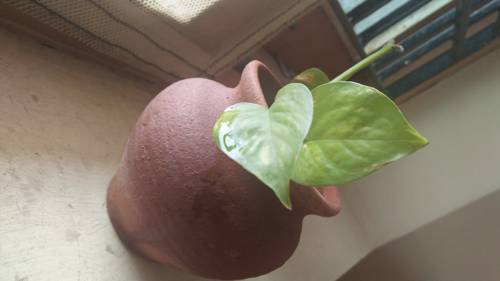
FAQ About Indoor Plant Potting Airflow Optimization

Why is airflow important for indoor plants?
Airflow is crucial for indoor plants as it helps regulate humidity levels, reduces the risk of mold and fungi, and improves the overall health of the plant. Good airflow ensures that the roots and leaves of plants have access to sufficient oxygen, which is essential for photosynthesis and nutrient uptake. Without adequate airflow, plants may become susceptible to diseases and poor growth.

How can I improve airflow around my indoor plant pots?
To improve airflow around indoor plant pots, you can space the pots apart to avoid crowding, use fans to circulate air, and choose pots with breathable materials such as terra cotta or clay. Additionally, placing pots on elevated stands can help air circulate more freely underneath the plants.

What are the signs of poor airflow in indoor plants?
Signs of poor airflow in indoor plants include yellowing leaves, slow growth, mold on the soil surface, and the presence of pests such as fungus gnats. If these symptoms are observed, it may indicate the need to adjust the plant's environment to improve airflow.

Can pot design affect airflow for indoor plants?
Yes, pot design can significantly affect airflow. Pots with drainage holes and those made of porous materials like terra cotta allow for better air circulation. Elevated pots or those with ridges can also enhance airflow, preventing waterlogging and promoting healthier root systems.

How do fans help in airflow optimization for indoor plants?
Fans help in airflow optimization by circulating air around the plants, which reduces humidity levels and prevents the buildup of stagnant air. This circulation prevents diseases like powdery mildew and ensures that leaves and roots receive adequate fresh air and oxygen.

Is too much airflow harmful to indoor plants?
While airflow is important, excessive airflow, particularly cold drafts, can harm indoor plants by causing stress and dehydration. It's essential to balance airflow, ensuring it's sufficient to prevent disease without exposing plants to constant drafts or dry conditions.

What materials for plant pots enhance good airflow?
Materials such as terra cotta, clay, and ceramic are excellent for enhancing airflow because they are porous, allowing air to pass through the pot walls. These materials help regulate moisture and temperature, creating a healthier environment for roots.

Do self-watering pots affect airflow to roots?
Self-watering pots can affect airflow since they keep the soil constantly moist, potentially leading to reduced airflow if not managed correctly. Proper use involves ensuring the soil surface is periodically dried to promote airflow and prevent root rot.

How does indoor plant placement affect airflow?
Placement affects airflow by determining how much natural air can circulate around the plants. Placing plants near vents, windows, or above-ground surfaces can enhance airflow. Avoid placing them in tight corners or overcrowded areas where air movement is restricted.

Can using pebbles in the pot improve airflow?
Using pebbles at the bottom of plant pots can improve drainage, which indirectly aids airflow by preventing waterlogging. This setup ensures that excess water can drain away, allowing air to reach the root zone and prevent root suffocation.

Should I rotate my indoor plants for better airflow?
Rotating indoor plants can enhance airflow by exposing different parts of the plant to the air. This practice ensures uniform growth and helps prevent long-term issues caused by stagnant air conditions, such as mold and mildew on foliage.

What impact does high humidity have on indoor plant airflow?
High humidity levels can hinder airflow by creating a moist environment conducive to mold and mildew growth. This can lead to poor plant health and diseases. Utilizing dehumidifiers and proper ventilation can help manage humidity levels and improve airflow.

Are there any plants that require less airflow?
Some plants, such as ferns and mosses, thrive in higher humidity and might not require as much airflow as others. However, even these plants benefit from occasional air circulation to prevent the development of stagnant air and potential mold issues.

How does airflow affect photosynthesis in plants?
Airflow enhances photosynthesis by ensuring that plants have access to a constant supply of carbon dioxide and by regulating temperature and humidity. Proper airflow allows the stomata on the leaves to remain open, facilitating the gas exchange necessary for photosynthesis.

What are common misconceptions about plant airflow needs?
A common misconception is that indoor plants do not need as much airflow as outdoor plants due to the controlled environment. However, indoor plants still require sufficient airflow to prevent disease and promote healthy growth, even if they are not exposed to wind like outdoor plants.

Can I use ventilation systems to improve plant airflow indoors?
Yes, ventilation systems can be used to improve indoor plant airflow by consistently circulating air. This can be particularly useful in larger indoor growing spaces. Ventilation helps regulate temperature and humidity, further supporting plant health.

How do air purifiers impact plant health?
Air purifiers can positively impact plant health by cleaning indoor air, thus reducing pollutants and dust that can settle on leaves, impeding photosynthesis. However, they do not replace the need for good physical airflow around plants, which is crucial for root and foliar health.

Is it beneficial to aerate the soil of potted plants?
Yes, aerating the soil in potted plants can significantly improve root health by allowing oxygen to penetrate the root zone. This can be done by gently poking holes in the soil, which helps improve drainage and airflow, reducing the risk of root rot.

How often should I check airflow conditions for my indoor plants?
It's a good habit to check airflow conditions periodically, especially when rearranging plants, changing seasons, or if signs of plant stress appear. Regular monitoring ensures that any issues with humidity or stagnant air are addressed promptly, maintaining healthy plant growth.

Do different plants have different airflow requirements?
Yes, different plants have varying airflow needs based on their natural environments. For instance, succulents and cacti require more arid conditions with less humidity, necessitating more airflow, while tropical plants may need balanced humidity but still benefit from good airflow.
